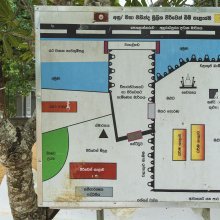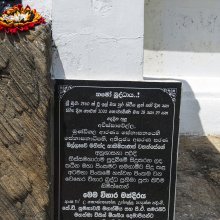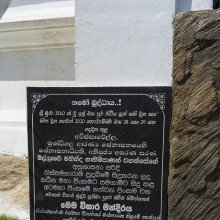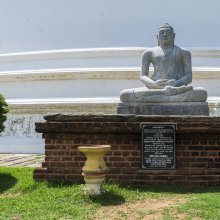Mahinda, Mahimda: 5 definitions
Introduction:
Mahinda means something in Buddhism, Pali, the history of ancient India, Jainism, Prakrit. If you want to know the exact meaning, history, etymology or English translation of this term then check out the descriptions on this page. Add your comment or reference to a book if you want to contribute to this summary article.
Images (photo gallery)
In Buddhism
Theravada (major branch of Buddhism)
Source: Pali Kanon: Pali Proper Names1. Mahinda Thera. Son of Asoka and brother of Sanghamitta. He was fourteen at the time of the coronation of his father and was ordained at the age of twenty, his preceptor being Moggaliputtatissa. The ordination was performed by Mahadeva, while Majjhantika recited the kammavaca. Mahinda became an arahant on the day of his ordination (Mhv.v.204ff.; Dpv.v.24 f ; Sp.i.51). He spent three years in study of the Doctrine under his preceptor, and, later, when the latter retired to Ahoganga, he left his one thousand disciples for seven years under the care of Mahinda (Mhv.v.233; Sp.i.52). When the Third Council was held, Mahinda had been for twelve years a monk and was charged with the mission of converting Ceylon. But he delayed for six months, until Devanampiyatissa became king. He then went to Dakkhinagiri and from there to his birthplace, Vedisagiri, staying in Vedisagiri vihara and visiting his mother, the queen Devi. Still one more month he tarried, teaching the Doctrine to Bhanduka, and then, on the full moon day of Jettha, at the request of Sakka, he went, in company with
Itthiya, Uttiya, Sambala, Bhaddasala, Sumanasamanera and Bhanduka,to Ceylon, where he converted Devanampiyatissa by preaching to him the Culahatthipadopama Sutta. Later, on the same day, he preached the Samacitta Sutta. The next day, at the request of the king, he visited Anuradhapura, travelling through the air and alighting on the site of the (later) Pathamacetiya. After a meal at the palace he preached the Petavatthu, the Vimanavatthu and the Sacca Samyutta, and Anula and her five hundred companions became sotapannas. Later, in the elephant stables, he preached the Devaduta Sutta to the assembled people, and, in the evening, the Balapandita Sutta, in Nandanavana. The night he spent in Mahameghavana, and on the next day the king gave the park to Mahinda, on behalf of the Order.
Mahinda pointed out to the king various spots destined to be connected with the growth of the sasana in Ceylon, offering flowers at the same, and at the site of the (later) Maha Thupa, he described the visits of the Four Buddhas of this kappa to Ceylon. On the fourth day he preached the Anamatagga Sutta in Nandanavana and helped the king in defining the boundaries of what later became the Mahavihara. On the fifth day he preached the Khajjaniya Sutta, on the sixth the Gomayapindi sutta, and on the seventh the Dhammacakkappavattana Sutta.
The pasada first built for the residence of Mahinda was called Kalapasada parivena. Other buildings associated with him were the Sunhataparivena, the Dighacanka parivena, the Phalagga parivena, the Therapassaya parivena, the Marugana parivena, and the Dighasandasenapati parivena.
Twenty six days Mahinda stayed in Mahameghavana, and on the thirteenth day of the bright half of Asalha,
Theravāda is a major branch of Buddhism having the the Pali canon (tipitaka) as their canonical literature, which includes the vinaya-pitaka (monastic rules), the sutta-pitaka (Buddhist sermons) and the abhidhamma-pitaka (philosophy and psychology).
General definition (in Buddhism)
Source: Wisdom Library: BuddhismMahinda (महिन्द) refers to one of the descendants of king Naradeva: an ancient king from the Solar dynasty (sūryavaṃśa) and a descendant of Mahāsaṃmata, according to the Mahābuddhavaṃsa or Maha Buddhavamsa (the great chronicle of Buddhas) Anudīpanī chapter 1, compiled by Ven. Mingun Sayadaw. Naradeva’s son founded Rocana and reigned. He and his descendants in that city were seven. The last of these seven kings was named Mahinda. His son founded Campā and reigned. He and his descendants in that city were twelve. The last of these fifty-seven kings [...] was named Nāga-deva.
India history and geography
Source: academia.edu: The Chronological History of Ancient Sri LankaMahinda, the son of Ashoka was born in 1561 BCE, the 204 th year from 1765 BCE. Mahinda and Sanghamitra’s visit to Sri Lanka and the coronation of Devanampiya Tissa took place in the 236 th year i.e. 1529 BCE. Purana and Attakatha were the earliest chronicles of Sri Lanka but not available today. Dipavamsa and Mahavamsa give the chronology of Sri Lanka from King Devanampiya Tissa to King Mahasena.

The history of India traces the identification of countries, villages, towns and other regions of India, as well as mythology, zoology, royal dynasties, rulers, tribes, local festivities and traditions and regional languages. Ancient India enjoyed religious freedom and encourages the path of Dharma, a concept common to Buddhism, Hinduism, and Jainism.
Languages of India and abroad
Pali-English dictionary
Source: BuddhaSasana: Concise Pali-English Dictionarymahinda : (m.) a personal name; the chief of gods.

Pali is the language of the Tipiṭaka, which is the sacred canon of Theravāda Buddhism and contains much of the Buddha’s speech. Closeley related to Sanskrit, both languages are used interchangeably between religions.
Prakrit-English dictionary
Source: DDSA: Paia-sadda-mahannavo; a comprehensive Prakrit Hindi dictionary1) Mahiṃda (महिंद) in the Prakrit language is related to the Sanskrit word: Mahendra.
2) Mahiṃda (महिंद) also relates to the Sanskrit word: Māhendra.
3) Māhiṃda (माहिंद) also relates to the Sanskrit word: Māhendra.
Prakrit is an ancient language closely associated with both Pali and Sanskrit. Jain literature is often composed in this language or sub-dialects, such as the Agamas and their commentaries which are written in Ardhamagadhi and Maharashtri Prakrit. The earliest extant texts can be dated to as early as the 4th century BCE although core portions might be older.
See also (Relevant definitions)
Starts with: Mahimdaphala, Mahindaguha, Mahindarama, Mahindasena, Mahindasena-parivena, Mahindasenavasa, Mahindatalaka, Mahindatata, Mahindatatavapi, Mahindaupusaya.
Ends with: Mahamahinda.
Full-text (+260): Mahendra, Damavihara, Nivattacetiya, Sunhata-parivena, Mahamahinda, Kovilaragama, Dhammikasilamegha, Mahindatata, Panhambamalaka, Sanniratittha, Mahindatatavapi, Anuradhapura, Dipani, Sidupabbatagama, Mahamallaka, Mahalekha, Mahindasena, Polonnaruwa, Campa, Therapassaya-parivena.
Relevant text
Search found 22 books and stories containing Mahinda, Mahimda, Mahiṃda, Māhiṃda, Māhinda; (plurals include: Mahindas, Mahimdas, Mahiṃdas, Māhiṃdas, Māhindas). You can also click to the full overview containing English textual excerpts. Below are direct links for the most relevant articles:
Mahavamsa (by Wilhelm Geiger)
Chapter 13 - The Coming Of Mahinda
Chapter 20 - The Nibbana Of The Thera
Dipavamsa (study) (by Sibani Barman)
Advice To Rāhula (by Nyanaponika Thera)
A Short history of Lanka (by Humphry William Codrington)
Chapter III - The medieval kingdom to the Chola conquest in the eleventh century (479 AD—1070AD)
Chapter I - The Beginnings and the conversion to Buddhism (543 BC—161 BC)
Vinaya Pitaka (3): Khandhaka (by I. B. Horner)
Third set of nine cases < [13. Accumulation (Samuccaya)]
Dhammapada (Illustrated) (by Ven. Weagoda Sarada Maha Thero)
Verse 270 - The Story of a Fisherman Named Ariya < [Chapter 19 - Dhammaṭṭha Vagga (Established in Dhamma)]



